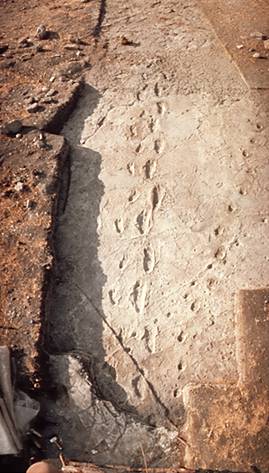Australopithecines: 5.3 to 1.6 mya
At some stage in our distant past bipedal hominids split from quadrupedal apes. We know that this first happened in Africa. Probably on the open savanna after climate changes dried out moist forests and forced hominids into long distant foraging. The so-called Savannah Hypothesis argues that hominids were forced to stand to help avoid predators and hunt for food. However, after the discovery of early hominids that remained in forests and also became bipedal, once again the jury was out on the savannah hypothesis.
However, standing upright and walking on two feet is a basic requirement for inclusion in the human lineage. And in the great rift valley in Eastern Africa, the fossil rich sites began to tell remarkable stories.
In 1974 Lucy was discovered in the Awash valley of Ethiopia's Afar Depression. It was a 40% complete fossilized skeleton of a small adult female, aged about 25. Fragments of Lucy's pelvis and thigh bones strongly suggest that she walked upright, over 3 million years ago. Lucy was classified as Australopithecus Afarensis.
 In 1978 the Leakey's discovered at Laetoli, Tanzania, parallel trails of footprints made by three individual hominids 3.6 million years ago. They were made in damp volcanic ash and preserved when they dried and hardened. The biped's shock absorber, the arch, is evident in the footprints of this Australopithecus Afarensis.
In 1978 the Leakey's discovered at Laetoli, Tanzania, parallel trails of footprints made by three individual hominids 3.6 million years ago. They were made in damp volcanic ash and preserved when they dried and hardened. The biped's shock absorber, the arch, is evident in the footprints of this Australopithecus Afarensis.
Paleoanthropologists discovered many more examples of this species that could stand, walk and run upright. While Australopithecines were smaller than modern humans, they had legbones and feet which were more man-like than ape-like. These discoveries from Afar, Laetoli and other East African sites indicate that what we now call collectively, Australopithecus Afarensis, thrived here some three to four million years ago. So not too long previous to this time the Australopithecines (southern apes) split from the quadrupedal apes and took separate evolutionary paths. But even though bipedalism had freed the hands of Australopithecus Afarensis for new uses, there is no sign that they developed or used tools (but this is still open for debate). More than likely one species of Australopithecine gave rise to the first of the Homo genus, Homo Habilis.

